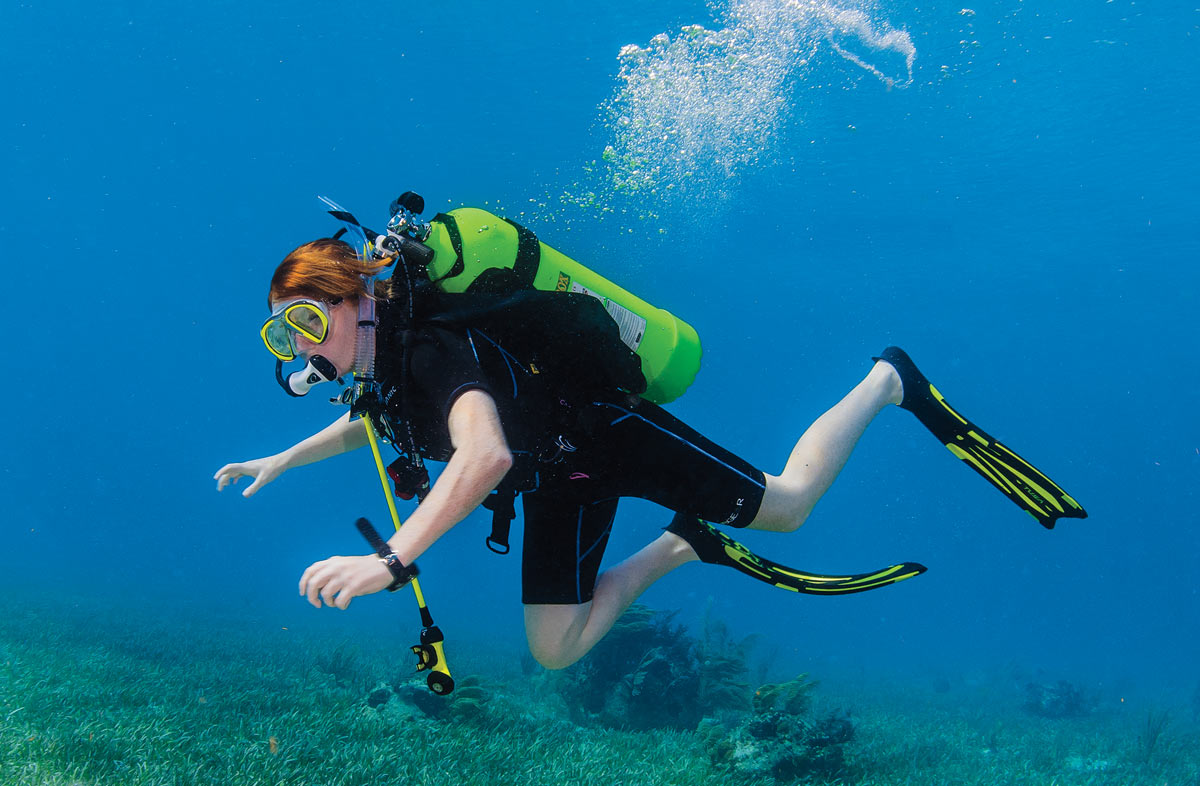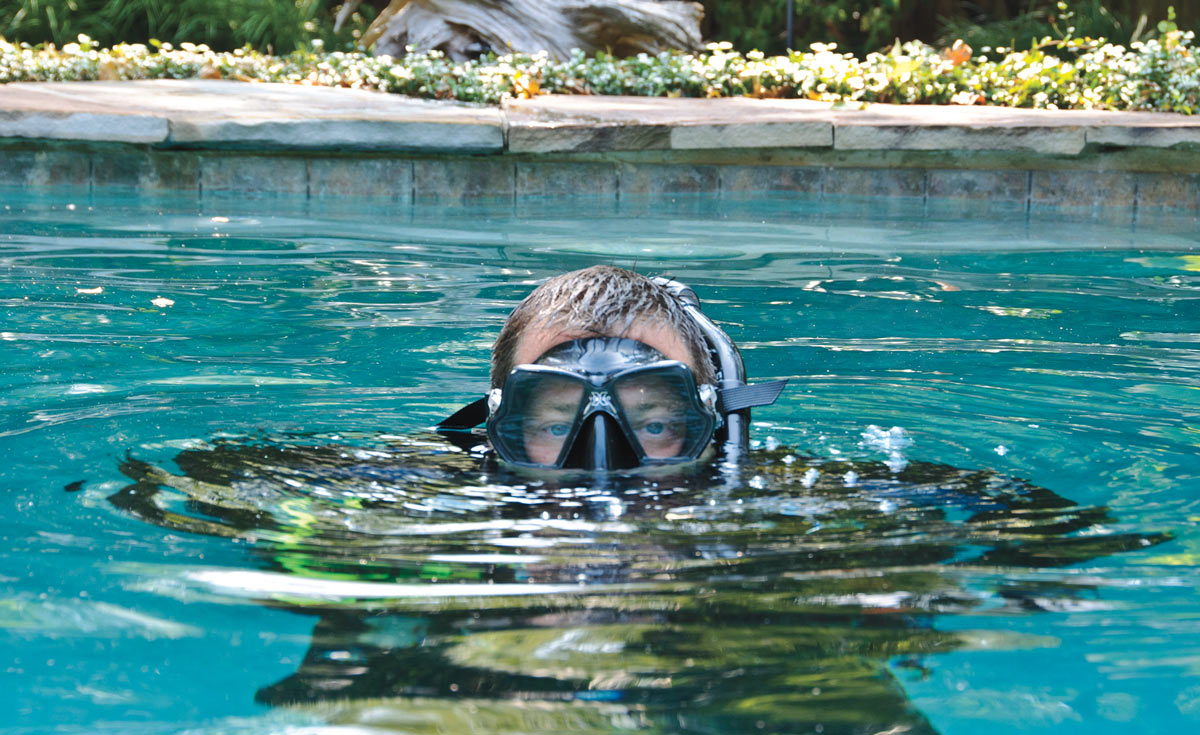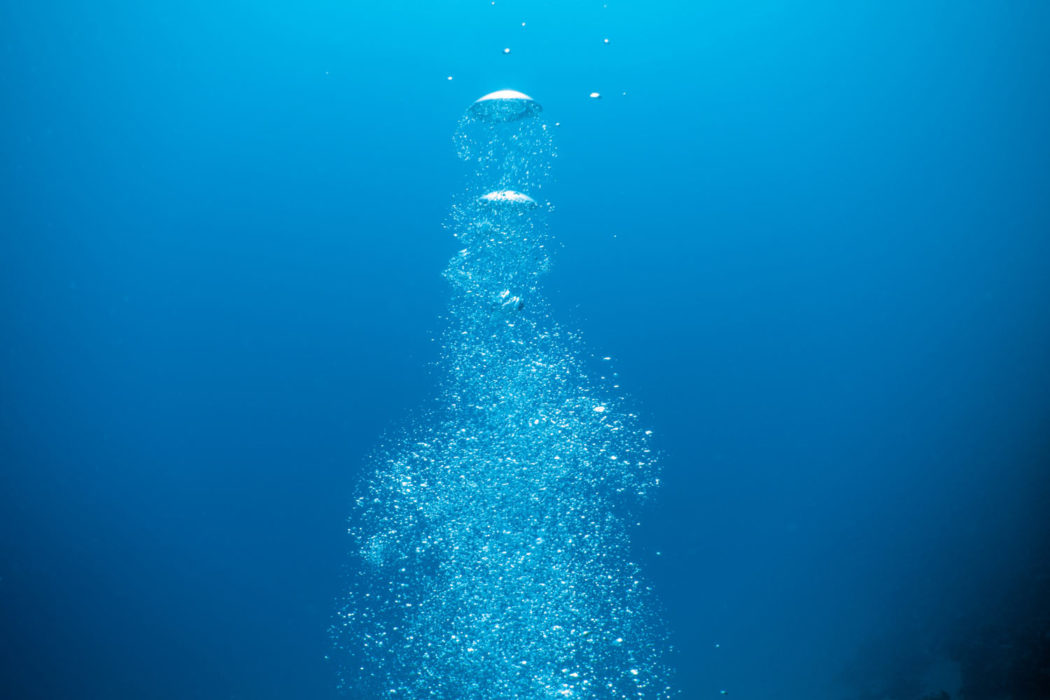Molokini is one of Hawaii’s most popular dive sites; thousands of divers a year visit this unique cinder cone that sits like a half-moon crater two miles (3.2 km) off Maui’s south shore. Many who visit Molokini are infrequent divers who just can’t pass up the opportunity for such a unique experience during their Hawaiian vacation.
As a dive instructor and underwater videographer, I dove Molokini several days a week. The first dive each morning was a circuit that took the guided dive group to a depth of 60 feet (18 m) where we visited some whitetip sharks, a couple of spotted moray eels, a diver-friendly octopus and any other creatures that might happen by.
The average diver could complete this circuit with sufficient air left in his or her tank to spend a few minutes exploring beneath the boat before reaching the bottom-time limit or running low on air. However, out of a boatload of divers there were some who had better than average air consumption, some who made it back to the boat with little air to spare and nearly always one or two who used significantly more air than the others. On a few occasions the heavy breathers presented a challenge for the dive staff.

Proper body alignment and gear configuration affects air consumption. Secure dangling gear for a streamlined equipment package, and avoid swimming with the arms. Instead, opt for a more horizontal body position with arms at the side. Rather than bent-knee “bicycle” kicking, use long, slow kicks. Photo by Barry & Ruth Guimbellot.
Factors That Affect Air Usage
Air consumption is an individual matter. If two divers sit on shore breathing from the same brand of regulator and equal-size, equally filled scuba cylinders, after a few minutes both will have reduced the pressure remaining in their tanks, but one will have used more air than the other. Even out of the water divers use air at differing rates.
The amount of air used begins with the diver’s size and physical conditioning. Generally speaking, a larger diver is likely to consume more air than a smaller diver. Physical fitness is also a factor. A diver who is in good aerobic condition typically uses less air than someone who does not exercise regularly.
Once you enter the water there are even more factors that affect air consumption. Here’s a quick review of the physics lesson you received during your initial scuba certification. Ambient pressure increases by 1 atmosphere (ATM) for every 33 feet (10 m) of increased depth, resulting in changes to the pressure/ volume/density of a diver’s air supply. At 33 feet (10 m) (2 ATM) the ambient pressure is double what it is at the surface; at 66 feet (18 m) (3 ATM) it’s three times greater than at the surface.
Consequently, at a depth of 33 feet you will consume twice as much air as you do on the surface. At 66 feet (18 m) three times as much as when sitting on shore breathing from the regulator. So, the deeper we dive, the more air we consume (See Figure 1).
Another factor that affects your rate of air consumption is physical exertion. The harder you work while underwater, the more air you use. I use the word work in the context of the physical demand that is placed on your body. The greater the demand, the more air you require to sustain normal body functions.
Physical demand can result from a number of circumstances and how you react to them. Similar to walking rapidly versus strolling, swimming timed laps as compared with leisurely making your way from one end of the pool to the other. Finning hard to circumnavigate a reef places more demand on your body and thus requires more air than taking your time exploring each and every ledge and crevice.
Current also has a major effect on air consumption. Swimming against a current is comparable to running uphill. The harder you work, the more air you consume. On the other hand, going with the current as in drift diving, you use less air. More exertion into the current, less with the current.
Body alignment is another factor affecting air consumption. When you plow through the water with a diagonal orientation — moving horizontally, but with your upper torso significantly higher than your fins — you create increased drag (resistance) in the water. This drag causes you to use more energy, which in turn requires more air.
When there is increased physical demand, there is increased air consumption. No way of getting around it. However, physical demand affects each of us differently. A top athlete may not find any of the above tasks or circumstances physically demanding, but on the opposite end of the spectrum a person in average to poor physical condition may find that even the slightest increase in physical exertion raises his breathing rate.
Physical conditioning is important, but there is another factor that plays a role in how much air you consume — the psychological side of diving. Think about the last time you became nervous over something. You began to sweat, your pulse increased, your stomach became knotted and you felt jittery all over. That’s the way some people, especially new divers, may initially feel just prior to entering the water on scuba. We all know that such anxiety is usually short-lived; however, divers who are apprehensive use more air than someone who is confident and relaxed.
Some divers, especially inexperienced, infrequent ones, experience that nervous sensation when their air supply begins to run low. Once their pressure gauge dips below 1,000 PSI (69 bar) they seem to use air even faster. Nervousness may be to blame; feeling anxious about running low on air may actually cause a diver to consume air more rapidly.
The last major factor that influences your rate of air consumption is what I call the perpetual motion factor. A diver who is constantly in motion will use more air than a diver who remains calm and minimizes unnecessary movement. Some divers are continuously sculling with their hands or fluttering their fins. Both of these unnecessary habits require energy and result in increased air consumption.
Another bad habit that some divers have is constantly adjusting the air in their buoyancy compensator (BC). The more you fidget with your buoyancy, clear your mask, etc., the more air you waste and therefore, the less air you have remaining for breathing.

Develop “air awareness” by monitoring your air supply often. Photo by Barry & Ruth Guimbellot.
Planning Air Consumption
If the divemaster asks you, “How is your air consumption?” how do you respond? “Pretty Good.” “Not bad.” “I don’t know.”
Knowing your rate of air consumption is important for planning dives. For example, the Molokini Crater dive referenced earlier requires that everyone in the guided group make it through the circuit and back to the boat without running below 500 psi (34 bar) remaining in their tank.
That dive is to a maximum depth of 60 feet (18 m) deep and takes about 45 minutes. If someone in the group begins running low on air prior to the planned turnaround point, the whole group must head back early. That’s why the divemaster typically asks divers in the group about their air consumption.
To know whether your air supply will last for 45 minutes on a dive to 60 feet you need to know your surface consumption rate (SCR), the rate of air you breathe while resting on the surface.
There are two ways to determine SCR. You can sit on shore or on board a boat and breathe from the regulator for a few minutes. You must note the exact tank pressure and time when you begin this exercise and note the same when you finish. If the tank pressure decreased by 200 psi (14 bar) in 10 minutes of breathing, your SCR is 20 psi (1.4 bar) per minute: 200 psi divided by 10 minutes = 20.
The other, more common, way to determine SCR is by measuring depth consumption rate (DCR) and then converting to SCR. Descend to 33 feet (10 m) and note on a dive slate the tank pressure and time. Dive normally at a consistent depth of 33 feet for 10 minutes. It is important that you maintain that depth throughout the timed monitoring period and swim at a leisurely pace. At the end of the timed period, note on the slate the ending tank pressure and the duration of the exercise, in this case 10 minutes.
Back on the surface following the dive, subtract the ending pressure noted from the beginning pressure to determine air used during the period. Now, divide the air used by the number of minutes of the test. The quotient is the DCR, how much air you used per minute at a depth of 33 feet (2 ATM); this is not your SCR. To determine SCR, divide DCR by two (2 ATM). The quotient is your SCR.
If you used 500 psi (34 bar) in the 10-minute test, your DCR is 50 psi (3.4 bar) per minute (500 psi ÷ 10 minutes = 50 psi per minute at 33 feet). To convert DCR at 33 feet to SCR, divide DCR by two (50 ÷ 2 = 25 psi [1.7 bar] SCR).
Calculating SCR sitting on the surface breathing from the scuba unit gives you a resting consumption rate. Monitoring your consumption at depth (DCR) and then mathematically calculating what it would be at the surface gives a more realistic reading because it reflects the additional air used while involved in diving activity.
There is nothing magical about monitoring usage for 10 minutes. Any period of time will work, but 10 minutes or longer provides a more accurate representation of your consumption rate, and using a 10-minute duration makes it easier to do the math.
There also is nothing special about 33 feet (10 m) other than 33 feet represents the depth of 2 ATM, where ambient pressure is twice what it is on the surface. Performing the consumption rate monitoring at exact atmosphere depths — 33, 66, 99 feet (10, 20, 30 m) — also facilitates the math; it is easier to divide by a round number than to calculate decimals.
Experienced divers typically don’t worry much about air consumption as long as they are diving a familiar environment and using their normal equipment. Most have mastered the air-use learning curve and have fine-tuned their consumption rates in every way possible.
But for new, inexperienced and infrequent divers, air consumption typically is a concern. That is when your SCR comes in handy. Simply knowing your SCR, however, is of little use unless you apply it to a real-life diving situation.
A dive trip to Seven Mile Beach in Grand Cayman may begin with a 100-foot (30 m) wall dive. The guided group descends on the mooring line and makes its way to the wall, where they might pass through a crevice or short tunnel that opens out on the sheer wall at a depth of around 100 feet. From there the group might swim along the face of the wall or navigate a series of swim-throughs that lead back up to the top of the wall.
During the predive briefing the divemaster explains what to expect and mentions that on a dive to this depth you will use more air than normal, so closely watch your air supply and notify him when it reaches 1,000 psi (69 bar). It is at this point that inexperienced divers and those who know that they use more air than most other divers begin thinking about their air consumption. You can see it in their faces, “Wonder if I can make it without running out of air?”
With a planned maximum depth of 100 feet (33 m) and a maximum bottom time of 25 minutes you can do the math and determine that, “Yes, I can do that profile and still have 500 psi remaining upon surfacing” or “No, I will likely be low on air before we get back to the boat.”
If you know your SCR you can estimate what your consumption rate will be at the maximum depth (EDCR). The maximum depth on this dive is 100 feet (33 m); that is 1 foot (0.33 m) deeper than 4 atmospheres, so to simplify the calculation we’ll use 4 atmospheres. At 4 ATM you’ll consume four times more air than at the surface. Assuming a SCR of 20 psi per minute, multiply your SCR by four to estimate that your EDCR at the maximum planned depth will be about 80 psi (5.5 bar) per minute. So, how long can he stay down?
First, confirm that the tank you are using is the same size as used when you calculated your SCR; if it is a different size, estimated air time (EAT) must be calculated using cubic feet per minute (CFM) (see sidebar on Page 28).
Begin the EAT calculation by noting the fill pressure, 3,000 psi (207 bar) in this example. Since you don’t want to breathe the tank dry, subtract 500 psi for a safety margin (3,000 psi – 500 psi = 2,500 psi). Now, determine EAT by dividing the useable tank pressure by your 80 psi per minute EDCR at the planned maximum depth (2,500 ÷ 80 = 37.5). This is a rough approximation that you will not be able to stay down beyond 37.5 minutes – your EAT for this dive. However, the planned bottom time is only 25 minutes, so you should have significant air remaining when you reboard the boat.
Also, it is important to point out that EDCR and EAT are based on you remaining at the planned maximum depth for the entire dive. It is unlikely that this will be the case. At minimum, the first few minutes will be spent descending, the last few ascending; during those parts of the dive you will be consuming air at slower rates than the calculated 80 psi (5.5 bar) per minute. Many air-integrated dive computers automatically calculate and display remaining air time (RAT) information.
If you do find yourself in a situation where your EDCR at the planned depth indicates that your air supply will not last through the profile, be upfront about it. Discuss it with the divemaster. There may be an alternative that will keep you safer and within your limits.
Don’t let the first time you calculate your SCR be the last. Periodically calculate your SCR because as you gain experience and your comfort level in the water increases your DCR will improve. There are, however, a number of things you can do to accelerate the process.

Photo by Barry & Ruth Guimbellot
Ways to Improve Air Consumption
Air consumption improves with experience. I have not known a new diver whose air consumption did not improve as he became more comfortable in the water and/or through changes in diving technique.
Wearing the appropriate amount of weight, which usually means reducing the amount of weight you wear, is a first step to improving air consumption. A properly weighted diver has a trim, horizontally oriented position in the water column. A diagonal orientation, in which the head and upper torso are higher than the legs, causes you to plow through the water rather than glide.
To become neutrally buoyant an overweighted diver must add excess air to the BC. This buoys the upper body and makes plowing that much more physically demanding. Weight yourself properly by conducting a weighting test each time you change equipment or move between salt and fresh water and your air consumption will definitely improve.
Streamlining is another sure thing that any diver can do to improve air consumption. Streamlining reduces drag, which is the resistance encountered as you move through the water. The greater your drag, the more effort you’ll expend. Increased effort means increased air demand, and there goes your air consumption.
Streamlining begins with securing all accessory gear close to your body. Fasten up your gauge console and octopus. Place your slate inside a buoyancy compensator pocket. The goal is to make your underwater profile resemble that of a dolphin — sleek and smooth with minimal drag.
Next, focus on your swimming technique. To become streamlined, take the form of a torpedo. Become sleek and smooth, with your head, torso, legs and fins on the same horizontal plane. Arms at your sides or folded across the torso. Fin with slow, deliberate motions.
Stay warm. Using the proper equipment for the environment will help you avoid quickly sucking down your air supply. Cold divers use more air because their bodies have to work harder to maintain core temperature. Wearing the proper thermal protection will keep you warm and extend your air supply.
Move slowly and relax. Energy-efficient divers cut through the water slowly, use an efficient kick and breathe long, slow and relaxed breaths. Every movement is deliberate and designed to generate propulsion using the least effort. Adhere to the planned profile and go no deeper than is necessary.
Energy-efficient divers do not constantly adjust their equipment and clear the mask. Once neutrally buoyant at the planned diving depth, use variations in lung volume to keep your depth constant. If you must rise a few feet to pass over an obstruction simply take a couple of deeper breaths. Then breathe slightly shallower for a moment or two to return to the original diving depth.
Relaxing underwater is an air conservation technique that is easier said than done. The more comfortable you are at depth, the less air you use. Think positive thoughts, slow down, breathe slowly and exhale fully; make every movement count, and before you know it you’ll begin to relax and your air supply will last longer and longer.

Photo by Barry & Ruth Guimbellot.
Air Consumption Terms to Remember
SCR = surface consumption rate — the air a diver uses at the surface, expressed in psi per minute.
DCR = depth consumption rate — the air a diver uses at a specific depth, expressed in psi per minute.
EDCR = estimated depth consumption rate — an estimate of the air a diver will use at a specific depth, expressed in psi per minute.
EAT = estimated air time — the estimated amount of time a diver’s air supply will last at a specific depth, expressed in minutes; based on psi/ minute or cubic feet/minute.
ATM = atmospheres.
CFM = cubic feet per minute — the cubic feet of air a diver uses in one minute.
ECFM = estimated cubic feet per minute — an estimate of the cubic feet of air a diver will use per minute at a specific depth.
RAT = remaining air time — a figure calculated and displayed real-time by most air-integrated dive computers.





